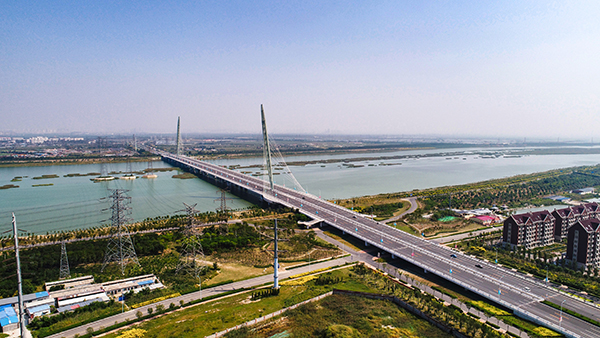
A photo of Jinghai district
Jinghai district is a subordinate district of Tianjin, situated in the southwest of Tianjin. It is adjacent to Binhai New Area to the east, faces Xiqing district across the Duliu River to the northeast. Jinghai is connected to Bazhou city to the northwest, and borders Wen'an county to the west. It is adjacent to Dacheng county to the southwest, connected to Huanghua city to the southeast, and borders with Qing county to the south. The total area is 1,475.68 square kilometers. By the end of 2024, Jinghai had a resident population of 777,000, of which 466,100 were urban residents and 310,900 were rural residents.
Subdistricts
As of 2024, Jinghai has 2 streets (Chaoyang Street and Huakang Street), 16 towns (Jinghai, Daqiuzhuang, Chenguantun, Dafengdui, Liangtou, Xizhaizhuang, Ziya, Caigongzhuang, Shuangtang, Wangkou, Yanzhuang, Zhongwng, Tanguantun, Duliu, Tuanbo, and Taitou) and 2 townships (Yang Cheng Zhuang and Liang Wang Zhuang). The government of Jinghai district is located at No. 99 Yingbin Avenue, Jinghai Town.
Geography
Jinghai has a temperate, monsoon climate, and distinct seasons. The landform belongs to the alluvial plain area in the south-central part of Tianjin. Jinghai is situated at the lower reaches of the Haihe River basin, has numerous river channels and is known as the "lower reaches of nine rivers". The South Canal, Ziya River, Daqing River, Heilonggang River, Ma Changjian River and Duliujian River run through the area. The Tuanbo Lake Reservoir is one of two "North-South Ecology" natural reserves in Tianjin, with a water capacity of 180 million cubic meters and a geothermal storage capacity of 8.4 billion cubic meters.
Natural Resources
Mineral Resources
The mineral resources discovered in Jinghai mainly include coal, coal gas, petroleum, natural gas, and underground hot water. Coal-bearing strata of the Carboniferous and Permian systems are widely distributed in the area, with abundant potential reserves. In the southeastern part of the area, including Zhongwang, Dazhuangzi, Dahaozhuang and Caigongzhuang townships, there are thick layers of Tertiary oil and gas shale formations, which are currently exploration and development areas of the Dagang Oilfield.
Land Resources
By the end of 2019, the total land area of Jinghai district was 146,482.22 hectares, including 56,239.5 hectares of arable land, 5,012.73 hectares of orchards, 21,483.74 hectares of forest land, 1,643.46 hectares of grassland, 351.5 hectares of wetland, 26,878.04 hectares of residential and independent industrial and mining land, 5,357.42 hectares of land for transportation, and 29,515.83 hectares of water areas and land for water conservancy facilities.
Water Resources
The total surface water resources in Jinghai averages 22.58 billion cubic meters annually, accounting for one-fifteenth of the total amount in the city. Among them, the self-produced water volume is 177.43 million cubic meters and the foreign water volume is 48.37 million cubic meters. In 2008, the per capita water resources occupancy was 378 cubic meters, making it a severely water-deficient area. The exploitable amount of groundwater in Jinghai is 82.14 million cubic meters, including 36.31 million cubic meters of deep water and 45.83 million cubic meters of shallow water.
Social Services
Social security
By the end of 2024, the number of urban enterprise employees who paid into the pension insurance was 142,400, and the number of government and public institution employees who paid into it was 18,100. The number of urban and rural residents who paid into the pension insurance was 158,500. The number of residents who paid into basic medical insurance was 653,500 in Jinghai district. The number of people who paid into unemployment insurance was 127,700, and the number of people who paid into work-related injury insurance was 132,300.
Medical and health care
By the end of 2024, there were a total of 706 medical and health care institutions in Jinghai district, with 2 district-level hospitals, and 16 private hospitals. There were 4,201 health technicians, including 1,770 licensed physicians, 267 licensed assistant physicians, and 1,365 registered nurses. At the end of the year, there were 2,117 licensed beds in medical and health care institutions.
Culture
By the end of 2024, Jinghai held 400 cultural activities, and had 1 public library, 384 rural libraries, and a collection of 1.05 million books (including electronic books). There was 1 cultural center, 20 cultural stations in townships (streets), and 1 museum. There was also 1 calligraphy and painting academy. There was 1 radio and television station, broadcasting a total of 7,104.51 hours of programming throughout the year.
Science and technology
In 2024, a total of 13 national, municipal, and county-level science and technology projects were implemented in Jinghai district. The number of patent granted was 3,141, including 295 invention patents. At the end of the year, there were 3 municipal key laboratories and 5 municipal engineering technology centers. There were also 539 national high-tech enterprises.
Education
By the end of 2024, Jinghai district had 3 secondary vocational schools, 51 regular secondary and middleschools, and 95 primary schools. Secondary vocational schools enrolled 897 students, with a total enrollment of 2,909 and 782 graduates. . Regular secondary schools enrolled 5,846 students, with a total enrollment of 16,336 and 4,882 graduates. Regular middle schools enrolled 8,970 students, with a total enrollment of 27,515 and 9,355 graduates. Primary schools enrolled 6,240 students, with a total enrollment of 42,966 and 8,837 graduates. Preschool education had 15,569 children enrolled, including 15,523 in kindergartens and 46 in affiliated preschool classes.




